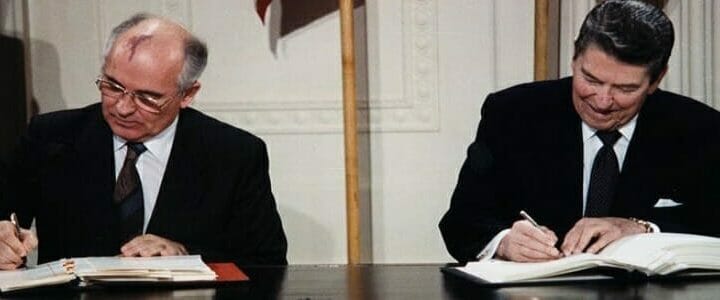The U.S. Government has acknowledged that since 2014, Russia has been in violation of the Intermediate-Range Nuclear Forces Treaty, signed by President Ronald Reagan and Soviet Chairman Mikhail Gorbachev in 1987. The landmark treaty eased tensions in Europe by banning “theater” nuclear-capable missiles with ranges between 500 km and 5,500 km.
This week, as National Security Adviser John Bolton visited Moscow, he announced that rather than continue to complain about Russian violations, the U.S. would simply withdraw from the treaty altogether. Cue the critics of President Donald Trump.
But despite the perception that Trump likes to pull out of treaties, this will be the first fully ratified treaty that the administration scraps. The two most famous examples of U.S. withdrawal from agreements under the Trump administration – the Paris climate accord and the Iran nuclear deal – were just agreements, not Senate-ratified treaties. We never signed the Trans-Pacific Partnership, and the threats of withdrawing from the North American Free Trade Agreement and the Korea Free Trade Agreement were enough to spur negotiations that led to new agreements on much more favorable terms.
History of the inf treaty and u.s. nuclear arsenal
In the late 1970s, the Soviet Union began fielding the nuclear-capable SS-20 missile as an upgrade to its SS-4 and SS-5 missiles. With a range of 5,000 km, it could reach any target in Europe, and many targets in the Middle East and Asia. To counter this threat, the U.S. deployed the Pershing II intermediate range missile that could travel 1,770 km, and the Gryphon ground-launched cruise missile that could travel 2,500 km. Unlike the Pershing II, the Tomahawk sea-launched cruise missile, or the air-launched cruise missile, the Gryphon could not deliver a conventional warhead.
It’s worth noting that the U.S. no longer maintains a stockpile of nuclear warheads for the Tomahawk, and the immediate replacement for the ALCM, the Joint Air-to-Surface Standoff Missile-Extended Range (JASSM-ER) is not nuclear capable. The Air Force does intend to field the nuclear Long Range Stand-Off (LRSO) missile sometime after 2020.
The Pershing II and Gryphon deployments sparked huge anti-nuclear protests across Europe, including one day in October 1983 when more than one million protestors turned out across West Germany. Whether those protests really had an direct impact on the decision to eliminate the missiles is debatable, since Reagan was reelected in one of the largest landslides in American history just a year later. But the marches made headlines and kept the issue in the front of people’s minds.
Reagan and Gorbachev signed the treaty in Washington in December 1987. The Senate’s ratification in May 1988 made it the first nuclear treaty the Senate had ratified since the 1972 Anti Ballistic Missile Treaty (from which, of course, President George W. Bush withdrew the U.S. in December 2001).
But in 2007, Russian President Vladimir Putin declared that “only the United States and Russia bear the responsibility to not create such weapons systems. It is obvious that in these conditions we must think about ensuring our own security.” In other words, “China and others are building these missiles, so Russia doesn’t care what the treaty says.”
So what does this actually mean?
In the short run really not much, despite the wails from the left. Russia has been deploying its SS-26 Stone missile, known as the Iskander-M in Russia, for years. Last year, the Trump administration accused Russia of secretly fielding the SSC-8 GLCM in violation of the treaty. But having destroyed its Pershings and Gryphons, NATO has no counterparts in its inventory. Developing a new intermediate range nuclear missile isn’t a simple task, either.
The U.S. will lose the ability to inspect some Russian missile equipment, but when they’re fielding weapons to which they will not admit having, inspections are largely for show.
Much like the formal move of the U.S. Embassy in Israel from Tel Aviv to Jerusalem, withdrawing from the INF Treaty is more a recognition of existing conditions than it is a truly new development. It doesn’t directly “punish” Russia for violating the treaty, and the U.S. can’t magically develop a new capability overnight.
In other words, it’s not the end of the world.




